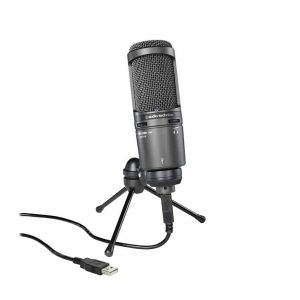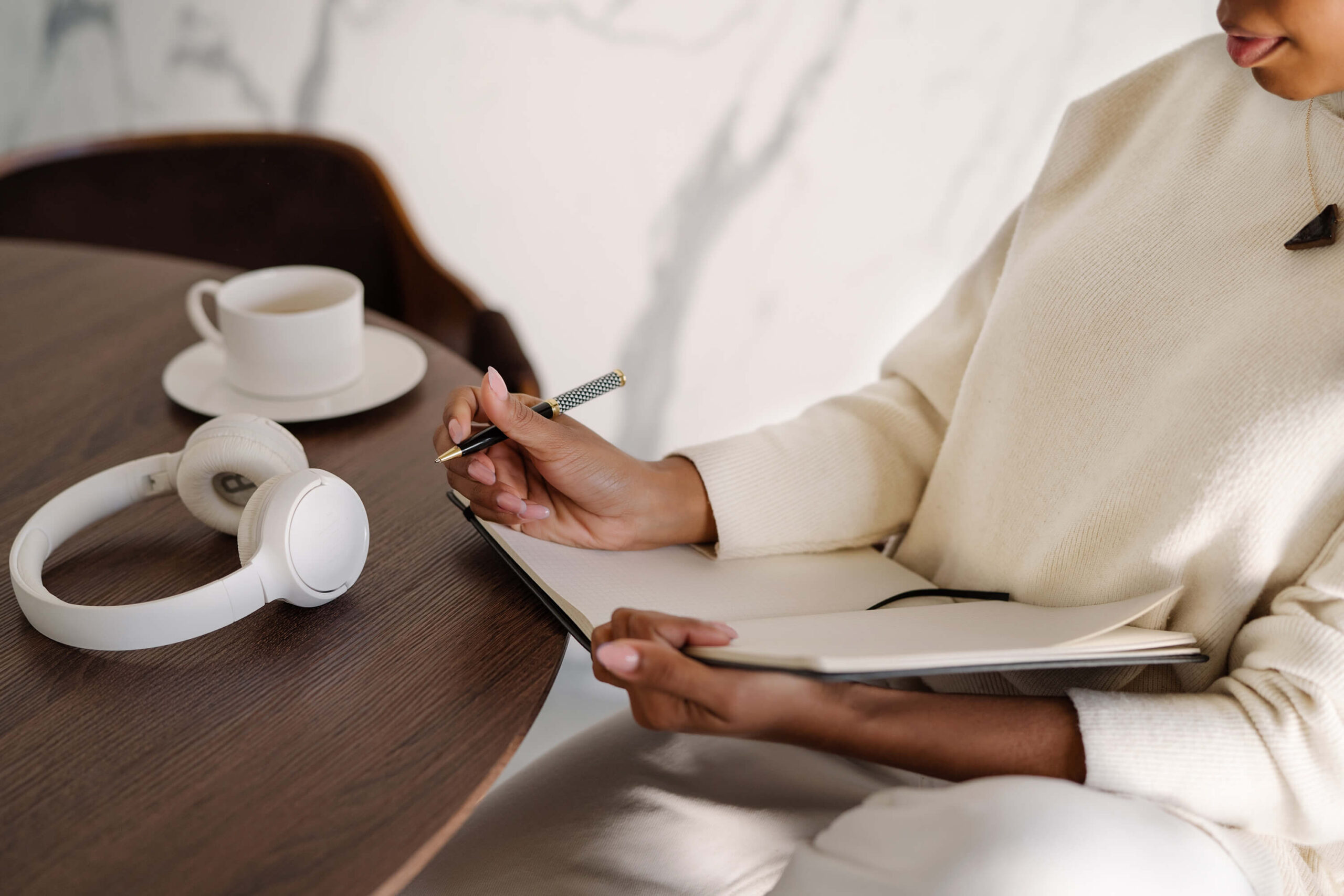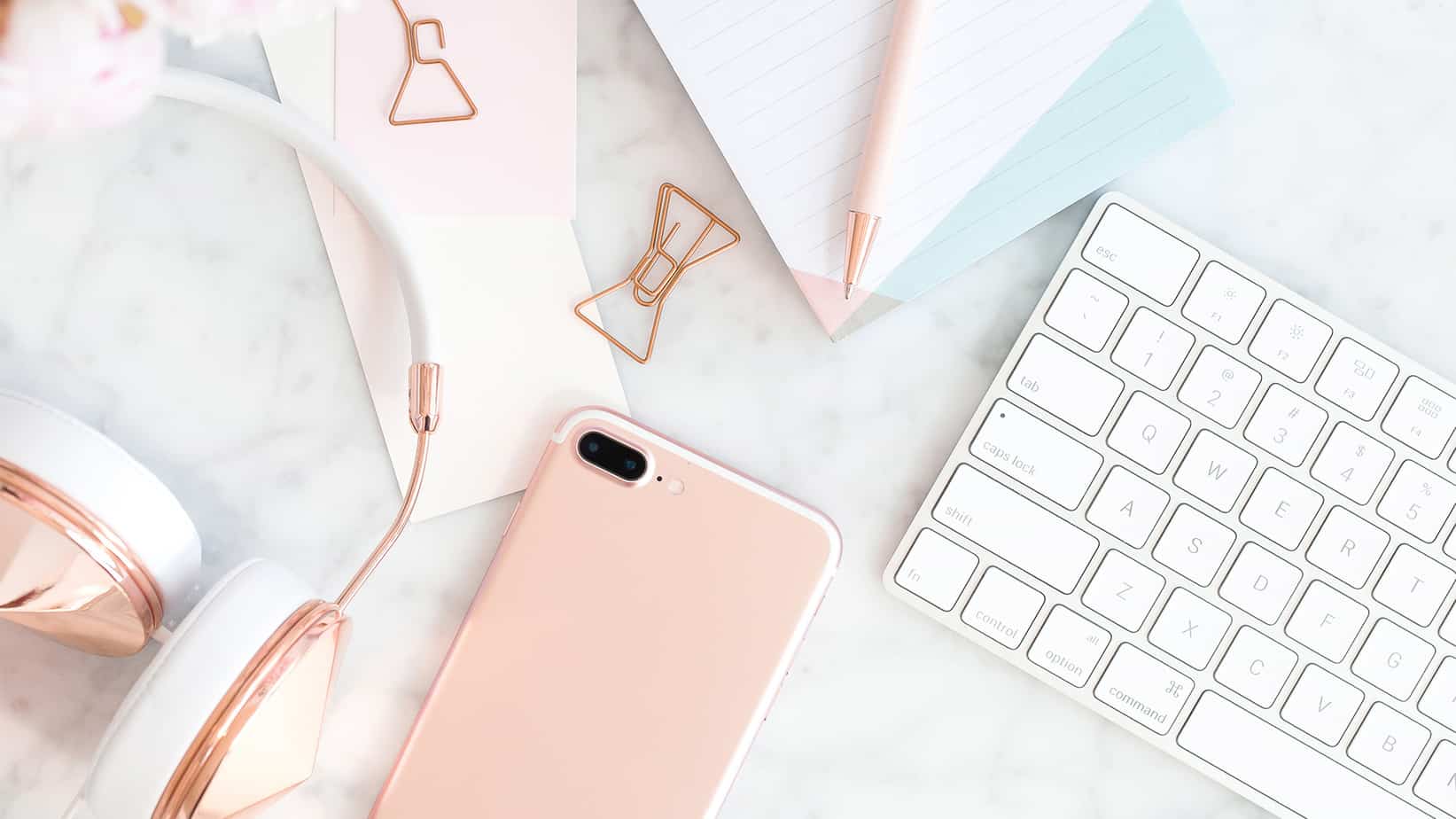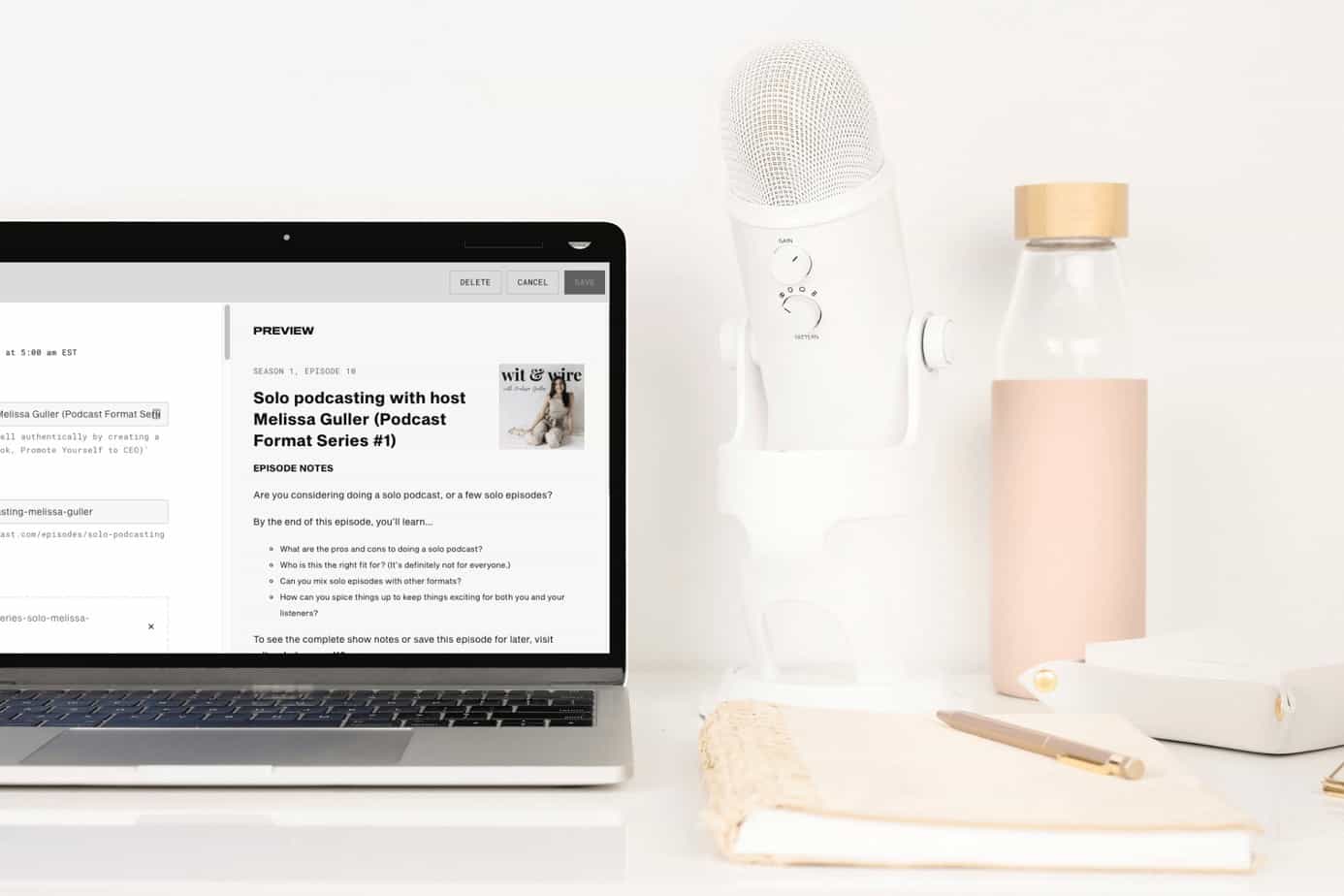If you’re a podcaster, YouTuber, or online course creator, then you might be in the market for a podcast or USB microphone.
That’s why we’ve done our research to make and update our top recommendations for USB microphones for online business owners and content creators on any budget.
Best starter microphone: Blue Yeti USB Microphone
The Blue Yeti is the microphone I personally used for my first two years as a podcaster and online course creator. I liked the ease of use, and I think the audio quality is great at its price point.
One of the biggest reasons why people choose the Blue Yeti over similar microphones is the option to change your sound recording pattern. There are settings for solo recording (cardioid), two-person recording (bi-directional), and even group recordings (omnidirectional).
📍Quick note: I’d still recommend two separate microphones for a co-hosted show. You’d have to sit very close to get quality audio on a shared microphone, plus it’s much easier to edit two voices when they’re recorded separately.
The Blue Yeti comes with a few basic controls right on the microphone:
- Mute button (when it blinks, it’s muted)
- 4 pattern choices (you’ll want cardioid, the little lima bean shape)
- Gain setting
- 3.5mm headphone jack, with volume control
The Yeti also comes on a stand, which means you won’t need to buy one separately. That said, buying a separate boom arm does improve the Yeti’s audio quality slightly, so it’s worth considering.
You have your choice of colors, and it’s typically priced around $100-$120.
Amazon: Blue Yeti USB Microphone
Best upgrade microphone: Shure MV7 microphone
Any microphone from Shure is going to be excellent. And although the Shure SM7B is often considered the gold standard microphone for podcasters, most online business owners don’t need to spend $500 on a microphone – and $100s more on additional equipment – to get high-quality audio.
Instead, many YouTubers, course creators, and podcasters would be better off choosing the Shure MV7, which was created after Shure noticed a growing demand from online creators for a USB microphone at a more affordable price point.
I’ve used the Shure MV7 for years and I love it. I’d easily recommend it to any creator looking for a microphone with great audio output that will last.
If you’re curious to learn more about the difference between our top two microphones, I recommend our full video comparison of the Blue Yeti vs. Shure MV7:
Learn More: Shure MV7 USB Podcast Microphone
Splurge pick: Shure SM7dB dynamic microphone
If you’re looking for the best possible microphone for podcasters, YouTubers, or online course creators, most experts agree that Shure is the brand to choose.
And although the SM7B is the long-standing gold standard in audio, the recently-released SM7Bd is our current top pick for online business owners because it’s been specifically tailored for online creators.
Not only does it introduce switches on the back of the mic, but it also introduces a pre-built preamp, which fixes a low gain problem in the SM7b. (It required a lot of creators to purchase a third piece of equipment – a cloudlifter – which is no longer necessary.)
💡 Since this is an XLR microphone – not a USB microphone – you’ll need an additional piece of equipment called an audio interface to connect to your microphone to your computer.
Our top recommendation is the Focusrite Scarlett 2i2, 4th gen.
Other great podcast microphones
The Yeti and Shure MV7 have been our top picks since 2021. But broadly, my favorite brands (for almost any microphone) are Rode, Shure, and Blue (now Logitech). Their mics all have different uses, but they’re all high-quality brands trusted by countless podcasters and radio broadcast professionals.
Here are a few additional microphones at different price points from my top brands, plus a few that are well-loved by many podcasters:
Audio-Technica AT2020USB Plus Condenser Microphone
When you factor in the pop filter and carrying case, this microphone is priced comparably to the Blue Yeti and is from another excellent brand (Audio-Technica).
This microphone is slightly more portable than the Yeti because it comes with a carrying case, and the stand is a folding tripod. But other than the aesthetics and stand type, the AT2020+ and the Blue Yeti will offer very similar sound quality. It’s another great choice.
Learn More: Audio-Technica AT2020USB Plus Condenser Microphone (Amazon)
Rode NT-USB Versatile Studio-Quality USB Cardioid Condenser Microphone
As I mentioned earlier, Rode is one of the brands I’d trust with almost any microphone. But the NT-USB is the one I’d personally choose for most podcasters.
The NT-USB is a highly versatile side-address microphone ideal for recording any kind of vocals with all mainstream recording applications. The body features a zero-latency 3.5mm headphone jack to monitor microphone input. A premium pop-filter is included, which fits onto the base of the mic, positioning the filter the ideal distance from the capsule to minimize plosives during singing or speech. Also provided is a stand mount with 3/8″ thread, a desktop tripod stand, and a pouch for storage.
Learn More: Rode NT-USB Versatile Studio-Quality USB Cardioid Condenser Microphone (Amazon)
CAD U37 USB Studio
The CAD U37 is a universal USB condenser microphone that works on both Macs and PCs.
At $59-$69, this budget choice still includes a stand and a USB cable. (Like the Blue Yeti, you’ll need to buy a pop filter separately.) From yet another solid audio brand, this is a great value-packed microphone if you’re on a budget.
You won’t get as many basic controls or sound recording patterns as you do with the Blue Yeti, and audio professionals would notice a difference in sound quality. But it’s very slight.
Learn More: CAD U37 USB Studio (Amazon)
What about the Audio-Technica ATR2100-USB Cardioid Dynamic USB Microphone?
This microphone is often recommended as a great choice for beginner podcasters.
Fans of the ATR2100 love that it focuses on the podcaster’s voice and doesn’t pick up much background noise. It’s also fairly portable since it’s smaller and lighter than the Blue Yeti.
However, during the pandemic, the pricing changed. This microphone is now usually sold closer to $100, and at that price, I’d choose the Blue Yeti instead. But I’m keeping this one on the list primarily because I’m asked about it often, and if you own it, it’s a solid pick.
Learn More: Audio-Technica ATR2100-USB Cardioid Dynamic USB Microphone (Amazon)
Podcast microphone accessories
In addition to your USB microphone, you’ll need a few additional tools to complete your in-home podcast studio setup:
Pop Filter
A pop filter is an inexpensive sound muffler that will make “p” sounds less harsh. (They won’t “pop” as much.) For under $20, this is a must-have accessory, no matter which microphone you choose.
Here are a few options I recommend:
- Pop Filter For Blue Yeti Microphone (Amazon)
- Aokeo Professional Microphone Pop Filter Mask Shield For Blue Yeti and Any Other Microphone (Amazon)
(Note: The Aokeo is cheaper than the first choice, but I think the arm is slightly harder to attach to your microphone.)
Audio Interface & Cables
Unless you’ve purchased an XLR microphone, you won’t need an audio interface. It looks like this:

The audio interface is what musicians and podcasting studios use to connect their XLR microphones to an editing device (like a computer). USB microphones like the Blue Yeti are a newer technology and have really improved tech-wise since the podcasting and gaming boom.
As I mentioned previously, I don’t recommend an XLR microphone for beginners since the USB mics are easier and sound just as good to the average listener. And if you go the USB route, you don’t need an audio interface.
That said, there are many amazing XLR microphones out there, so if you already have one, or think you’d prefer it, it’s a great choice. (Don’t let me stop you!)
Why does a great podcast microphone matter?
Even though your audience isn’t full of audio production experts, they’re all listening experts. In fact, you’re probably a listening expert yourself!
Think about how often we’re exposed to professional-quality audio. In every movie, TV show, and song we hear, we’re listening to high-budget high-quality audio perfection.
On the other hand, we also know exactly what bad audio sounds like.
We’ve all been on a Zoom call where all you hear is, “Thanks, Mandy for sh—-ing—– {static static fizzle fizzle}.” Those grainy, staticky conference calls are what your podcast will sound like if you don’t invest in the right microphone.
And since we can’t afford to lose your listeners based on something as fundamental as audio quality, we need to get the right microphone in your hands ASAP.
How different could the best podcast microphone possibly be? (audio samples)
I really want you to hear the difference for yourself. So here are two audio clips I recorded: one with my computer microphone and one with a Blue Yeti.
I recorded both in the same sitting, so everything is the same except the microphone. Also, these are raw audio clips, which means I have made zero edits or adjustments.
First, this is what a recording sounds like using my computer microphone:
Doesn’t it sound like I’m far away? I’m literally sitting at my computer, but it’s very echo-y, which distracts me from the content.
Compare that to round two. Here’s what a recording sounds like using my Blue Yeti microphone:
Can you hear how much clearer it sounds? Instead of feeling like I’m halfway across the room, now it feels like we’re in a room together.
And that’s what I want you to sound like.
Quick Note: I’ve been shocked to realize how many new podcasters don’t invest in the right microphone. So when you choose one of our favorites from the list below, it’s one more big way your podcast will stand out from the pack.
Microphone vocabulary, explained
If you’ve done any microphone research on your own, I’m sure you may have noticed a few new terms and acronyms in their descriptions.
So if you’re looking for a crash course, here are a few terms defined and compared:
XLR microphones vs. USB microphones
There are two ways that your microphone might connect to your computer:
- USB Microphones: These microphones come with a cord that connects the microphone to a USB outlet on your computer. No additional equipment needed.
- XLR Microphones: Unlike USBs, XLR microphones do not plug directly into a computer. Instead, they plug into what’s called an Audio Interface, aka a snazzy little rectangle that sits on your desk and accepts cords from different places.
Although XLR is the gold standard for audio professionals and musicians, today’s USB microphones have come a long way, and even audio experts agree that the output from a (good quality) USB microphone is often too slight for the average listener to notice.
So in my experience, the simplicify of using a USB microphone will be the best pick for most content creators and online business owners.
Condenser microphones vs. dynamic microphones
If USB vs XLR answers, “How does this microphone connect to my computer?” then this distinction asks, “How is the microphone itself built?”
Condenser microphones are like a magnifying glass for all audio. They’re very sensitive, and they pick up sound in a very detailed and accurate way.
That’s why our top microphones for new podcasters are mostly condenser mics. Your microphone should ideally focus on just your voice and then capture your beautiful words as precisely as possible.
But the problem with condenser microphones can be background noise. Because they’re so sensitive, they’ll pick up on a lot of background noise if you’re in a loud room. But if you’re recording in a quiet place – which is what we recommend! – then a condenser mic could be right for you.
Dynamic microphones are typically used to record loud sounds and a narrower range of frequencies, so if you talk right into the microphone, they can be better for recording because they won’t catch as much of the background noise as a condenser microphone would.
That said, you’ll lose a little bit of richness in your tone with a dynamic microphone. But for some at-home spaces, they still sound better, so it all comes down to testing in your space.
The other noteworthy consideration is the power source. Because of the way condenser microphones are built, they always have a cord that connects to an external power source (like your computer).
On the other hand, dynamic microphones can be self-powered, which means you could take one on the go and record with the microphone alone.
So overall, there’s no universal best choice between condenser or dynamic microphones. It all comes down to your recording space, and we’ve used both successfully in our home office with minimal background noise.
PS: Prefer to listen instead of read?
This blog post became so popular that I created a full podcast episode about microphones. Plus, there’s a bonus section at the end where I share the top mistake I see podcasters making with their new microphones.
LISTEN OR SUBSCRIBE FOR FREE IN YOUR FAVORITE PODCAST APP:
Apple Podcasts | Spotify | Google Podcasts | Overcast | RSS
Latest content updates
We keep our recommendations up-to-date. As of October 2023, our top picks remain unchanged, but we added a few honorable mentions and refreshed the layout of this post.
Transparency Disclaimer: This post contains Amazon links. As an Amazon Associate, we earn from qualifying purchases.





